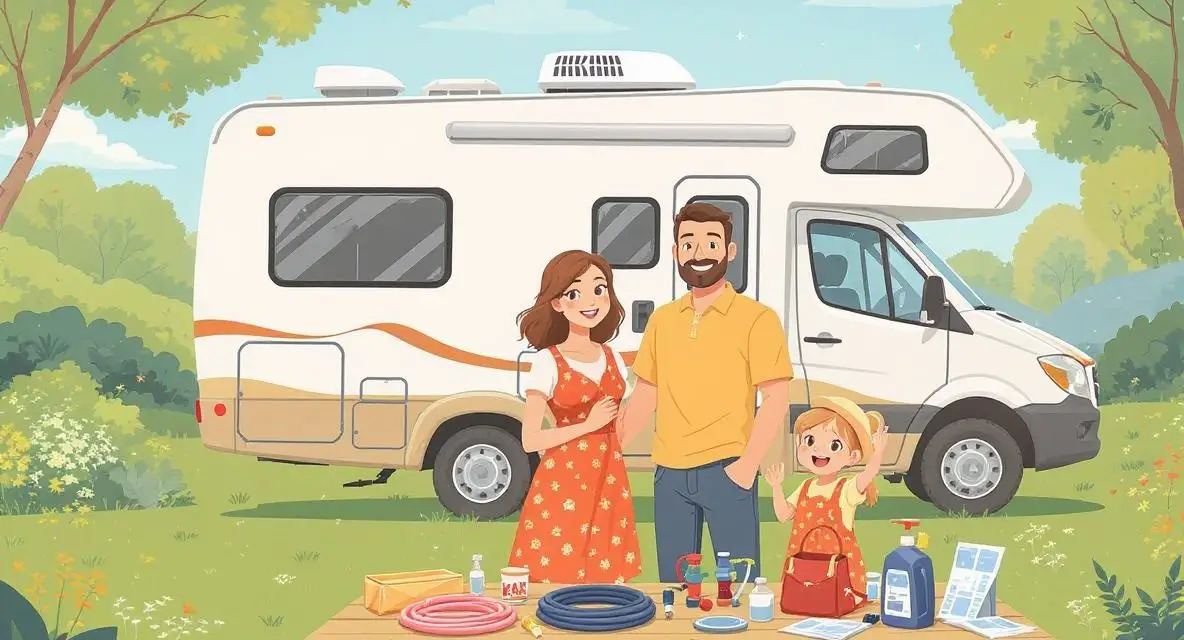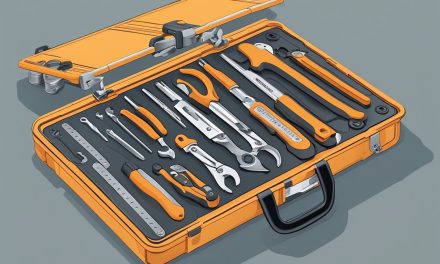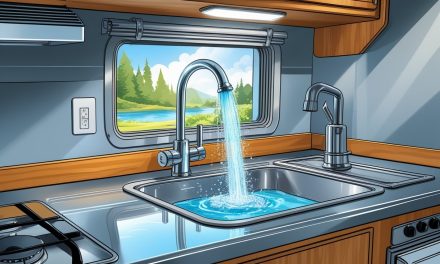Would you like to save this article?
(As an amazon affiliate, we earn a commission when purchasing via our links below)
You’ve just dropped a small fortune on your dream RV, and you’re probably thinking the hard part is over. Well, buckle up, buttercup, because buying your RV is like buying a house – it’s just the down payment on a lifetime of “Oh, I need THAT too” moments.
According to recent RV industry statistics, 11.2 million American households now own RVs, with 25.1 million RV trips taken annually. But here’s the kicker – most new RV owners spend an additional $1,500-$3,000 on essential items before they can even take their first camping trip. Think of your RV purchase like an onion – you’ve only seen the outer layer, and now we’re about to peel back that first layer to reveal the dozen absolute essentials that separate successful RV adventures from expensive disasters.
1. Insurance: Your Financial Safety Net (Because Murphy’s Law Loves RVs)
The Reality Check: RV insurance isn’t just recommended – it’s legally required for motorhomes and highly recommended for towable units. According to Progressive Insurance, the average RV insurance premium runs $594 annually for travel trailers and $1,052 for motorhomes. However, comprehensive coverage can range from $600 to $3,000 per year depending on your RV’s value and usage.
Key Statistics:
- 68% of RV owners carry full comprehensive coverage
- Insurance claims for RVs increased 23% in 2024 due to weather-related damage
- The average RV insurance claim costs $8,500 to resolve
Your RV is essentially both a truck and a house on wheels, which makes insuring it as confusing as trying to explain TikTok to your grandmother. The insurance companies have to figure out how to cover something that can crash into a tree AND have that tree fall on it while you’re sleeping inside. It’s like they’re insuring Schrödinger’s vehicle – simultaneously a home and a car until something goes wrong.
2. Water Hose: Not Your Garden Variety Solution
The Reality Check: That garden hose in your garage? Forget about it. RV water hoses are BPA-free, drinking-water safe, and designed to handle the unique challenges of RV life. A quality 50-foot RV hose costs around $25, but it’s worth every penny.
Key Statistics:
- 87% of RV parks have water hookups located more than 25 feet from campsites
- Standard garden hoses contain lead and other chemicals unsafe for drinking water
- RV hoses are tested to FDA standards for potable water systems
You might think you’re being clever by saving $17 on a garden hose, but you’re essentially creating a chemical cocktail that would make a scientist weep. Plus, that cheap hose will crack in the first freeze, leaving you as waterless as a fish in the desert. It’s like trying to save money on parachutes – technically possible, but the consequences are memorable.
3. Pressure Regulator: The $30 Shield Against Plumbing Armageddon
The Reality Check: RV plumbing systems are designed for 40-60 PSI, but many campgrounds deliver water at 80-120 PSI. A pressure regulator costs around $30 and prevents thousands in damage.
Key Statistics:
- 90% of RV plumbing failures are caused by excessive water pressure
- Campground water pressure can exceed 120 PSI (normal home pressure is 40-60 PSI)
- RV faucets and toilets fail at pressures above 60 PSI
Skipping a pressure regulator is like playing Russian roulette with your plumbing system, except all the chambers are loaded and you’re guaranteed to lose. One Michigan RV owner learned this lesson when 85 PSI water pressure turned his brand-new RV into an indoor swimming pool. The repair bill? $3,200. That $30 pressure regulator suddenly looks like the bargain of the century.
4. Electrical Cord: Your Lifeline to Civilization
The Reality Check: Not all RVs come with electrical cords, and the ones that do might not be long enough. A quality 50-foot electrical cord ranges from $60-$300 depending on amperage (30-amp vs 50-amp).
Key Statistics:
- 30-amp cords provide 3,600 watts of power
- 50-amp cords provide 12,000 watts of power
- 73% of RV electrical issues stem from inadequate cord length or quality
Campground electrical pedestals are positioned by people who apparently hate RV owners with the passion of a thousand suns. I’ve seen sites where the electrical hookup is 40 feet away from where your RV door needs to be. It’s like they used a random number generator to decide where to put the power. Don’t be that person running extension cords like you’re decorating for Christmas in July.
5. Sewer Hose: Dealing with the Dirty Business
The Reality Check: What goes in must come out, and that requires a quality sewer hose system. The popular Rhino Hose costs around $60-$80 for a 20-foot setup, but don’t go shorter – you’ll regret it.
Key Statistics:
- 95% of RVs don’t include sewer hoses
- The average RV generates 40 gallons of gray water and 10 gallons of black water per day
- Sewer hose failures create $500-$2,000 in cleanup costs
Nothing ruins a camping trip faster than a sewer hose disaster. It’s like Mother Nature’s way of reminding you that you’re not actually roughing it if you can’t handle a little poop management. Pro tip: carry a 5-pound scuba weight to hold your hose connection in place. It’s weird, but it works better than prayers and hope.
6. Soap: Because Touching Poop Requires Proper Hygiene
The Reality Check: This seems obvious, but you’d be surprised how many first-time RVers forget the basics. A good supply of soap, hand sanitizer, and cleaning supplies costs around $10-$15 but prevents countless problems.
Key Statistics:
- 68% of camping-related illnesses are preventable with proper hygiene
- RV water tanks can harbor E. coli and other bacteria without proper sanitation
- Campground restrooms have 3x higher bacterial counts than home bathrooms
Pack like you’re going to a place where running water is more of a gentle suggestion than a guarantee. I’ve been to campgrounds where the “running water” was more like a sad drizzle. Your immune system will thank you for bringing enough soap to scrub away the memories of what you just had to touch.
7. Water: The Liquid of Life (With a Side of Caution)
The Reality Check: While most RV park water is potable, many experienced RVers prefer bottled water or filtration systems. A Brita pitcher costs $26, while bottled water runs $3-$4 per case.
Key Statistics:
- 34% of RV parks have water quality issues during summer months
- Filtered water systems remove 99.9% of common contaminants
- The average RV family uses 50 gallons of water per day
Here’s what veteran RVers know – RV park water often tastes like it was filtered through a gym sock that’s been marinating in regret. Even if it’s technically safe, it often tastes like disappointment with a hint of sulfur. Your coffee will taste better, your family will complain less, and you’ll actually want to drink water instead of rationing it like you’re crossing a desert.
8. Plates and Utensils: Civilized Eating in the Wilderness
The Reality Check: Paper plates and plastic utensils are fine for quick trips, but melamine dishware ($30 per set) makes RV life more enjoyable. Factor in $20 for decent silverware and $30 for reusable cups.
Key Statistics:
- Average RV family uses 15-20 plates per week-long trip
- Melamine dishes are 70% lighter than ceramic
- Paper plate costs add up to $200+ annually for regular RVers
Buy melamine plates in bright colors – not because they’re prettier, but because when you inevitably drop one in the dark campground grass, you’ll actually find it. White plates disappear faster than your camping budget at a tourist trap gift shop. It’s like they develop stealth technology the moment they hit the ground.
9. Toilet Paper: The Great RV Debate
The Reality Check: The RV toilet paper debate rages on, but septic-safe toilet paper (around $10-$15) works fine for most systems. Don’t forget paper towels for cleanup duties.
Key Statistics:
- 78% of RV manufacturers recommend septic-safe toilet paper
- RV holding tanks average 40-gallon capacity
- Improper toilet paper causes 23% of RV plumbing service calls
The whole “special RV toilet paper” thing is mostly marketing designed to separate you from your money faster than a carnival game. Use septic-safe toilet paper (the same stuff you’d use with a home septic system) and you’ll be fine. The real secret? Use plenty of water when you flush, because your black tank has feelings too.
10. Bedding: Because RV Beds Are Weird
The Reality Check: RV beds come in strange sizes that don’t match standard home bedding. An RV king is shorter and narrower than a standard king. Budget $100-$150 for proper RV bedding.
Key Statistics:
- 89% of RV beds are non-standard sizes
- RV queen beds are typically 60″ x 75″ (vs standard 60″ x 80″)
- Amazon carries 200+ different RV bedding sizes
RV beds are like snowflakes – no two are exactly alike, and they’re all slightly disappointing. That “RV Queen” could be anything from 58″ to 72″ wide. It’s like RV manufacturers got together and decided to make bedding as confusing as possible. Measure twice, buy once, and prepare to discover that your RV’s “queen” bed is about as royal as a medieval peasant’s cot.
11. Tire Pressure Gauge: Your Guardian Against Blowout Hell
The Reality Check: RV tires operate at 80-110 PSI (much higher than car tires), and proper pressure prevents 90% of tire failures. A quality gauge costs $25-$50 but prevents thousands in damage.
Key Statistics:
- 90% of RV tire failures are caused by under-inflation
- RV tires lose 1-2 PSI per month naturally
- Tire blowouts cause $3,000-$15,000 in damage on average
Don’t trust gas station gauges – they’re beaten to death and about as accurate as a weather forecast. RV tires operate at pressures that would make your car tires explode in terror. It’s like the difference between a gentle squeeze and a hydraulic press. For dual-wheel RVs, get a gauge with a swivel head, because trying to check inside tire pressure with a straight gauge is like performing surgery with oven mitts.
12. Hitch (If You’re Towing): The Connection That Matters
The Reality Check: If you’re towing, you need a proper hitch rated for your RV’s weight. Costs range from $50 for basic hitches to $3,000+ for fifth-wheel installations.
Key Statistics:
- 67% of RV dealers overestimate towing capacity
- Improper hitches cause 45% of towing accidents
- Weight distribution hitches reduce trailer sway by 85%
RV dealers are notorious for stretching towing capacity estimates like taffy. Your half-ton pickup might “technically” tow that 8,000-pound trailer, but add water, food, and gear, and you’re looking at white-knuckle driving that would make a stunt driver nervous. When in doubt, buy more truck than you think you need. Your sanity (and your marriage) will thank you.
The Bottom Line: Budget for Reality
| Essential Item | Cost Range | Why You Need It |
|---|---|---|
| Insurance | $600-$3,000/year | Legal requirement, financial protection |
| Water Hose | $25 | Safe drinking water |
| Pressure Regulator | $30 | Prevents plumbing disasters |
| Electrical Cord | $60-$300 | Power for your RV |
| Sewer Hose | $40-$80 | Waste management |
| Tire Pressure Gauge | $25-$50 | Prevents blowouts |
| Bedding | $90-$150 | Comfort and proper fit |
| Plates & Utensils | $40-$50 | Civilized dining |
| Soap & Paper Products | $10-$15 | Hygiene and cleanup |
| Water/Filtration | $15-$30 | Better tasting water |
Total Investment: $935-$3,685 (plus annual insurance)
The Road Ahead
Your RV adventure doesn’t have to turn into a financial disaster movie. By investing in these essential items upfront, you’re buying peace of mind and ensuring your first camping trip is memorable for all the right reasons. Remember, the goal isn’t to have the most expensive gear – it’s to have the right gear that keeps you safe, comfortable, and happy on the road.
The RV industry generates $140 billion in annual economic activity and supports 680,000 jobs, proving that you’re joining a massive community of people who’ve figured out that life’s too short for boring vacations. With 25.1 million RV trips taken annually, you’re in good company – just make sure you’re properly prepared company.
SOURCES:
- Living Phase 2 – 12 Must Purchase Items For A New RV
- Camper Champ – USA RV Camping Statistics 2024
- Progressive Insurance – RV Insurance Cost
- MarketWatch – Average Cost of RV Insurance 2025
- Fresh Water Systems – RV Water Pressure Problems
- Good Sam – RV Tire Blowouts
- RV Life – RV Plumbing Problems
- Home Guide – RV Insurance Cost
- Camping World – 30 Amp vs 50 Amp
- RV Geeks – Water Pressure Regulator





